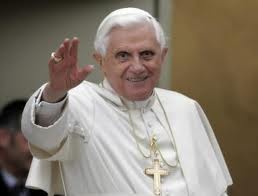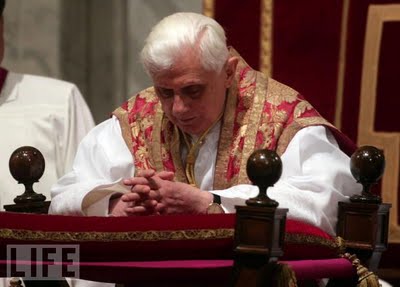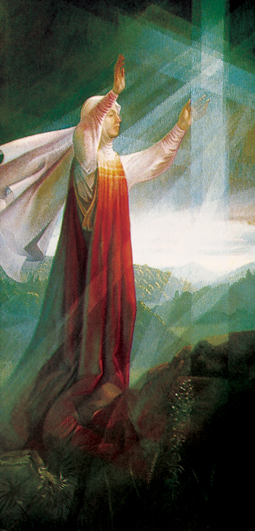Dear Brothers and Sisters,
Today I would like to speak to you about Blessed Angela of Foligno, a great medieval mystic who lived in the 13th century. People are usually fascinated by the consummate experience of union with God that she reached, but perhaps they give too little consideration to her first steps, her conversion and the long journey that led from her starting point, the “great fear of hell”, to her goal, total union with the Trinity. The first part of Angela’s life was certainly not that of a fervent disciple of the Lord. She was born into a well-off family in about 1248. Her father died and she was brought up in a somewhat superficial manner by her mother. She was introduced at a rather young age into the worldly circles of the town of Foligno, where she met a man whom she married at the age of 20 and to whom she bore children. Her life was so carefree that she was even contemptuous of the so-called “penitents”, who abounded in that period; they were people who, in order to follow Christ, sold their possessions and lived in prayer, fasting, in service to the Church and in charity.
Certain events, such as the violent earthquake in 1279, a hurricane, the endless war against Perugia and its harsh consequences, affected the life of Angela who little by little became aware of her sins, until she took a decisive step. In 1285 she called upon St Francis, who appeared to her in a vision and asked his advice on making a good general Confession. She then went to Confession with a Friar in San Feliciano. Three years later, on her path of conversion she reached another turning point: she was released from any emotional ties. In the space of a few months, her mother’s death was followed by the death of her husband and those of all her children. She therefore sold her possessions and in 1291 enrolled in the Third Order of St Francis. She died in Foligno on 4 January 1309.
The Book of Visions and Instructions of Blessed Angela of Foligno, in which is gathered the documentation on our Blessed, tells the story of this conversion and points out the necessary means: penance, humility and tribulation; and it recounts the steps, Angela’s successive experiences which began in 1285. Remembering them after she had experienced them, Angela then endeavoured to recount them through her Friar confessor, who faithfully transcribed them, seeking later to sort them into stages which he called “steps or mutations” but without managing to put them entirely in order (cf. Il Libro della beata Angela da Foligno, Cinisello Balsamo 1990, p. 51). This was because for Blessed Angela the experience of union meant the total involvement of both the spiritual and physical senses and she was left with only a “shadow” in her mind, as it were, of what she had “understood” during her ecstasies. “I truly heard these words”, she confessed after a mystical ecstasy, but it is in no way possible for me to know or tell of what I saw and understood, or of what he [God] showed me, although I would willingly reveal what I understood with the words that I heard, but it was an absolutely ineffable abyss”. Angela of Foligno presented her mystical “life”, without elaborating on it herself because these were divine illuminations that were communicated suddenly and unexpectedly to her soul. Her Friar confessor too had difficulty in reporting these events, “partly because of her great and wonderful reserve concerning the divine gifts” (ibid., p. 194). In addition to Angela’s difficulty in expressing her mystical experience was the difficulty her listeners found in understanding her. It was a situation which showed clearly that the one true Teacher, Jesus, dwells in the heart of every believer and wants to take total possession of it. So it was with Angela, who wrote to a spiritual son: “My son, if you were to see my heart you would be absolutely obliged to do everything God wants, because my heart is God’s heart and God’s heart is mine”. Here St Paul’s words ring out: “It is no longer I who live, but Christ who lives in me” (Gal 2: 20).
Let us then consider only a few “steps” of our Blessed’s rich spiritual journey. The first, in fact, is an introduction: “It was the knowledge of sin”, as she explained, “after which my soul was deeply afraid of damnation; in this stage I shed bitter tears” (Il Libro della beata Angela da Foligno, p. 39). This “dread” of hell corresponds to the type of faith that Angela had at the time of her “conversion”; it was a faith still poor in charity, that is, in love of God. Repentance, the fear of hell and penance unfolded to Angela the prospect of the sorrowful “Way of the Cross”, which from the eighth to the 15th stages was to lead her to the “way of love”. Her Friar confessor recounted: “The faithful woman then told me: I have had this divine revelation: “after the things you have written, write that anyone who wishes to preserve grace must not lift the eyes of his soul from the Cross, either in the joy or in the sadness that I grant or permit him'” (ibid., p. 143). However, in this phase Angela “did not yet feel love”. She said: “The soul feels shame and bitterness and does not yet feel love but suffering” (ibid., p. 39), and is unrequited.
fact, is an introduction: “It was the knowledge of sin”, as she explained, “after which my soul was deeply afraid of damnation; in this stage I shed bitter tears” (Il Libro della beata Angela da Foligno, p. 39). This “dread” of hell corresponds to the type of faith that Angela had at the time of her “conversion”; it was a faith still poor in charity, that is, in love of God. Repentance, the fear of hell and penance unfolded to Angela the prospect of the sorrowful “Way of the Cross”, which from the eighth to the 15th stages was to lead her to the “way of love”. Her Friar confessor recounted: “The faithful woman then told me: I have had this divine revelation: “after the things you have written, write that anyone who wishes to preserve grace must not lift the eyes of his soul from the Cross, either in the joy or in the sadness that I grant or permit him'” (ibid., p. 143). However, in this phase Angela “did not yet feel love”. She said: “The soul feels shame and bitterness and does not yet feel love but suffering” (ibid., p. 39), and is unrequited.
Angela felt she should give something to God in reparation for her sins, but slowly came to realize that she had nothing to give him, indeed, that she “was nothing” before him. She understood that it would not be her will to give her God’s love, for her will could give only her own “nothingness”, her “non-love”. As she was to say: only “true and pure love, that comes from God, is in the soul and ensures that one recognizes one’s own shortcomings and the divine goodness…. Such love brings the soul to Christ and it understands with certainty that in him no deception can be found or can exist. No particle of worldly love can be mingled with this love” (ibid., p. 124-125). This meant opening herself solely and totally to God’s love whose greatest expression is in Christ: “O my God” she prayed, “make me worthy of knowing the loftiest mystery that your most ardent and ineffable love brought about for our sake, together with the love of the Trinity, in other words the loftiest mystery of your most holy Incarnation…. O incomprehensible love! There is no greater love than this love that brought my God to become man in order to make me God” (ibid., p. 295). However, Angela’s heart always bore the wounds of sin; even after a good Confession she would find herself forgiven and yet still stricken by sin, free and yet conditioned by the past, absolved but in need of penance. And the thought of hell accompanied her too, for the greater the progress the soul made on the way of Christian perfection, the more convinced it is not only of being “unworthy” but also deserving of hell.
And so it was that on this mystical journey Angela understood the central reality in a profound way: what would save her from her “unworthiness” and from “deserving hell” would not be her “union with God” or her possession of the “truth” but Jesus Crucified, “his crucifixion for me”, his love.
In the eighth step, she said, “However, I did not yet understand whether my liberation from sins and from hell and conversion to penance was far greater, or his crucifixion for me” (ibid., n. 41). This was the precarious balance between love and suffering, that she felt throughout her arduous journey towards perfection. For this very reason she preferred to contemplate Christ Crucified, because in this vision she saw the perfect balance brought about. On the Cross was the man-God, in a supreme act of suffering which was a supreme act of love. In the third Instruction the Blessed insisted on this contemplation and declared: “The more perfectly and purely we see, the more perfectly and purely we love…. Therefore the more we see the God and man, Jesus Christ, the more we are transformed in him through love…. What I said of love… I also say of suffering: the more the soul contemplates the ineffable suffering of the God and man Jesus Christ the more sorrowful it becomes and is transformed through suffering” (ibid., p. 190-191). Thus, unifying herself with and transforming herself into the love and suffering of Christ Crucified, she was identifying herself with him. Angela’s conversion, which began from that Confession in 1285, was to reach maturity only when God’s forgiveness appeared to her soul as the freely given gift of the love of the Father, the source of love: “No one can make excuses”, she said, “because anyone can love God and he does not ask the soul for more than to love him, because he loves the soul and it is his love” (ibid., p. 76).
On Angela’s spiritual journey the transition from conversion to mystical experience, from what can be expressed to the inexpressible, took place through the Crucified One. He is the “God-man of the Passion”, who became her “teacher of perfection”. The whole of her mystical experience, therefore, consisted in striving for a perfect “likeness” with him, through ever deeper and ever more radical purifications and transformations. Angela threw her whole self, body and soul, into this stupendous undertaking, never sparing h erself of penance and suffering, from beginning to end, desiring to die with all the sorrows suffered by the God-man crucified in order to be totally transformed in him. “O children of God”, she recommended, “transform yourselves totally in the man-God who so loved you that he chose to die for you a most ignominious and all together unutterably painful death, and in the most painful and bitterest way. And this was solely for love of you, O man!” (ibid., p. 247). This identification also meant experiencing what Jesus himself experienced: poverty, contempt and sorrow, because, as she declared, “through temporal poverty the soul will find eternal riches; through contempt and shame it will obtain supreme honour and very great glory; through a little penance, made with pain and sorrow, it will possess with infinite sweetness and consolation the Supreme Good, Eternal God” (ibid., p. 293).
erself of penance and suffering, from beginning to end, desiring to die with all the sorrows suffered by the God-man crucified in order to be totally transformed in him. “O children of God”, she recommended, “transform yourselves totally in the man-God who so loved you that he chose to die for you a most ignominious and all together unutterably painful death, and in the most painful and bitterest way. And this was solely for love of you, O man!” (ibid., p. 247). This identification also meant experiencing what Jesus himself experienced: poverty, contempt and sorrow, because, as she declared, “through temporal poverty the soul will find eternal riches; through contempt and shame it will obtain supreme honour and very great glory; through a little penance, made with pain and sorrow, it will possess with infinite sweetness and consolation the Supreme Good, Eternal God” (ibid., p. 293).
From conversion to mystic union with Christ Crucified, to the inexpressible. A very lofty journey, whose secret is constant prayer. “The more you pray”, she said, “the more illumined you will be and the more profoundly and intensely you will see the supreme Good, the supremely good Being; the more profoundly and intensely you see him, the more you will love him; the more you love him the more he will delight you; and the more he delights you, the better you will understand him and you will become capable of understanding him. You will then reach the fullness of light, for you will understand that you cannot understand” (ibid., p. 184).
Dear brothers and sisters, Blessed Angela’s life began with a worldly existence, rather remote from God. Yet her meeting with the figure of St Francis and, finally, her meeting with Christ Crucified reawakened her soul to the presence of God, for the reason that with God alone life becomes true life, because, in sorrow for sin, it becomes love and joy. And this is how Blessed Angela speaks to us. Today we all risk living as though God did not exist; he seems so distant from daily life. However, God has thousands of ways of his own for each one, to make himself present in the soul, to show that he exists and knows and loves me. And Blessed Angela wishes to make us attentive to these signs with which the Lord touches our soul, attentive to God’s presence, so as to learn the way with God and towards God, in communion with Christ Crucified. Let us pray the Lord that he make us attentive to the signs of his presence and that he teach us truly to live. Thank you.


 You can find the book here.
You can find the book here.
 On October 11, 2012, I began recording a series for Discerning Hearts with Dr. Adrian Walker, which we recorded at “
On October 11, 2012, I began recording a series for Discerning Hearts with Dr. Adrian Walker, which we recorded at “ The Casa, located in Rome, was founded in 1990 by a group of friends and is directed by Rev. Jacques Servais, S.J.; Joseph Ratzinger (Pope Benedict XVI) has been closely associated with the
The Casa, located in Rome, was founded in 1990 by a group of friends and is directed by Rev. Jacques Servais, S.J.; Joseph Ratzinger (Pope Benedict XVI) has been closely associated with the 












